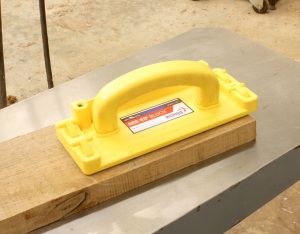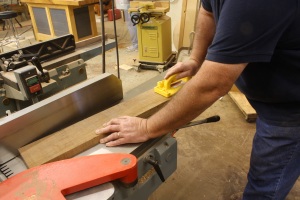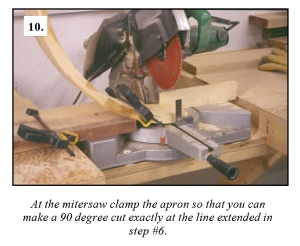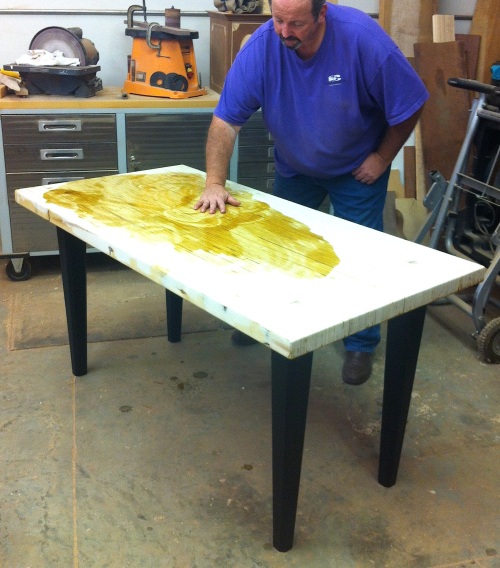“Their usual solution was a pair of large screws driven forward through the side rail into the front leg to supplement the hidden mortise-and-tenon joint. Each screw fits into a drilled and carved out ‘pocket’ or ‘screw gain’.”
 Immediately as I mention pocket screws, many woodworkers’ eyes roll back into the heads as if this method of joinery is totally unacceptable. Of course, there are places where the use of pocket screws is not the best choice. There are also places in woodworking where the joint is the perfect solution. It’s up to us to know the difference and where to draw the line.
Immediately as I mention pocket screws, many woodworkers’ eyes roll back into the heads as if this method of joinery is totally unacceptable. Of course, there are places where the use of pocket screws is not the best choice. There are also places in woodworking where the joint is the perfect solution. It’s up to us to know the difference and where to draw the line.
But the more you discover about pocket screws, the more fuzzy the line becomes. I’ve been in million-dollar homes, standing in kitchens that easily cost six figures, and the face frames on the cabinets were pocket screwed. Perfectly acceptable? You betcha. But that’s not furniture, right? No it’s not, but the quote above is about furniture. It’s about great furniture. Museum-quality stuff. The quote is taken from the book by Robert D. Mussey Jr. titled, “The Furniture Masterworks of John & Thomas Seymour.” The Father and son team used pocket screws. This method of joinery is not a new concept conjured up by the Kreg company, but it has elevated pocket screws to a whole new level.
The reason I write about pocket screws this morning is that I have a decision to make on the lowboy I’m building based on the piece found at the Connecticut Historical Society.
 The lowboy has no front rail at the top of the case – the drawers kick right up against the underside of the top. There is no room for wooden clips, and I hate “figure eight” fasteners. Therefore, to attach the top I need to be creative. Or not. The top on the original was nailed or pegged to the case. I’ve seen a number of antiques that have tops nailed in place, so it’s not out of the ordinary to do so. The problem I have is that at one of the pegs – it looks like a round dowel – the top has cracked. I’m not looking to repeat that problem, but I do need a secure top.
The lowboy has no front rail at the top of the case – the drawers kick right up against the underside of the top. There is no room for wooden clips, and I hate “figure eight” fasteners. Therefore, to attach the top I need to be creative. Or not. The top on the original was nailed or pegged to the case. I’ve seen a number of antiques that have tops nailed in place, so it’s not out of the ordinary to do so. The problem I have is that at one of the pegs – it looks like a round dowel – the top has cracked. I’m not looking to repeat that problem, but I do need a secure top.
In one of the photos I have of the original, you can see a metal angle used to gain a hold. I don’t think that is how the piece was built, but a later addition. Not what I’m after. As a result, I’m turning to pocket screws. And while I have respect for the Kreg joinery setup, I’m looking for something more traditional.
Yesterday I scanned the above-mentioned book to find ideas. I had it in my head that most pocket screws holes in antique furniture were basically v-shaped cuts, then I re-discovered the Seymour pockets. Their pockets were rounded, tapered and neatly shaped. I had something to work toward.
 My first attempt was using a carving gouge. I used a 9/20 fish-tail gouge to carve out a pocket (see the opening photo). It looked good, but was work heavy. As I studied the shape and design, I remembered a simple jig that I had built years and years back for use with my drill press, so I dug it out, dusted it off and made it work with a newer press. (On my older DP, the jig slipped over the table, but now I had to clamp the unit in place.)
My first attempt was using a carving gouge. I used a 9/20 fish-tail gouge to carve out a pocket (see the opening photo). It looked good, but was work heavy. As I studied the shape and design, I remembered a simple jig that I had built years and years back for use with my drill press, so I dug it out, dusted it off and made it work with a newer press. (On my older DP, the jig slipped over the table, but now I had to clamp the unit in place.)
The jig is built with its fence tilted back at a 22.5-degree angle. To align the workpiece, I position it at the intersection of the jig’s fence and base as it stands on an edge. The DP head and jig are arranged until the workpiece stands under the 1″-diameter drill bit so the back edge of the bit is even with the back face of the workpiece. Clamp everything secure. I then lay the piece back tight to the fence and add a couple of spring clamps as needed. To cut the rounded, tapered hole, drill as you normally do. (Play with the bit diameter and thickness of your workpiece to find the best results.)
Below is a test piece I made using all three methods. Each of the different pockets are aligned with the tools used to make those pockets. Which am I going to use? Easy. If you read the quote above, it states that the “screw gains” (fancy-speak for pocket holes) were drilled and carved. I plan to drill the bulk of the waste using the jig and drill press, then clean the gains with my carving gouge.

Which method would you use?
Build Something Great!
Glen
 I don’t often write about tools I use in my shop – you see them in the background of photos taken for my posts. I have only a couple tools or machines that have immediately changed the way I woodwork. While this tool is not one of those two, it is one of only a handful that I feel should be given extra consideration. The tool, as you can see in the opening photo, is the GRR-RIP Block. (It’s from MicroJig, the same folks that make the GRR-RIPPER 3D Pushblock, which is another tool I turn to when working with small pieces.)
I don’t often write about tools I use in my shop – you see them in the background of photos taken for my posts. I have only a couple tools or machines that have immediately changed the way I woodwork. While this tool is not one of those two, it is one of only a handful that I feel should be given extra consideration. The tool, as you can see in the opening photo, is the GRR-RIP Block. (It’s from MicroJig, the same folks that make the GRR-RIPPER 3D Pushblock, which is another tool I turn to when working with small pieces.) The hooks (the company says Gravity Heel technology) are great. The two hooks on the end that ride the board easily pivot up into the tool, flat and out of the way. The two hooks on the opposite end, drop to catch the board’s end – it doesn’t matter which end of the tool is which. The handle has a slight bend to one side, which should be held out or away from the fence. But because I ride the work piece at an angle to the blades whenever I can (see the photo at right), I don’t worry about having the push block oriented every time.
The hooks (the company says Gravity Heel technology) are great. The two hooks on the end that ride the board easily pivot up into the tool, flat and out of the way. The two hooks on the opposite end, drop to catch the board’s end – it doesn’t matter which end of the tool is which. The handle has a slight bend to one side, which should be held out or away from the fence. But because I ride the work piece at an angle to the blades whenever I can (see the photo at right), I don’t worry about having the push block oriented every time.



















